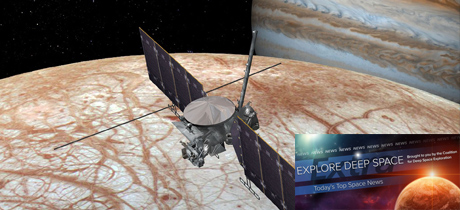In Today’s Deep Space Extra… Lab experiments suggest Jupiter’s moon Europa glows in the dark, a phenomenon that could help scientists learn if it can host life. Satellite manufacturers remain optimistic about overall demand in spite of pandemic-related business challenges.
Human Space Exploration
Now in Florida, NASA and SpaceX Crew-1 astronauts discuss what’s next
Florida Today (11/9): Speaking Monday with news reporters, the crew of the NASA-contracted Crew-1 mission to the International Space Station (ISS) spoke about their upcoming launch from the Kennedy Space Center (KSC) planned for Saturday at 7:49 p.m. EST. Working with an array of ground personnel, NASA astronauts Mike Hopkins, Victor Glover and Shannon Walker and Japanese astronaut Soichi Noguchi have had to deal with the restrictions of the coronavirus pandemic and currently the disruption from a tropical storm. “It’s been difficult, but at the same time, I would say people have done an amazing job of getting us to this point,” said Hopkins.
Moon 2020-something
The Space Review (11/9): Just over 18 months ago, U.S. National Space Council chair and Vice President Mike Pence directed NASA to return to the surface of the Moon with humans in 2024, a four-year acceleration. Faster seemed a good way to eliminate political risk, a familiar nemesis for ambitious human exploration initiatives. Then earlier this month, President Trump lost his re-election bid. That has led many to believe NASA’s best chance to return is later than 2024.
Space Science
Jupiter’s moon Europa glows in the dark, scientists say
NBC News (11/9): Lab experiments suggest that radiation from Jupiter causes its moon Europa to glow in the dark, a phenomenon that could help scientists learn if it can host life. Telescopes have yet to observe the glow, but Europa researchers developed their theory after building an ice chamber containing the chemicals thought to be on Europa’s surface and exposing it to a beam of high energy electrons to simulate the radiation from Jupiter. The possibility of a glow on Europa could be studied by the Europa Clipper, set to launch in the mid-2020s.
Mars: Mounting evidence for subglacial lakes, but could they really host life?
Space.com via the Conversation (11/9): New research published in Nature Astronomy points to the shallow network of subglacial lakes at Mars as the best place to seek evidence for extraterrestrial life. Though cold and dry on the surface, there is mounting evidence on the Red Planet for water frozen below the surface and potentially for liquid water below the Martian south pole.
Opinion
Closing the business case
Coalition Members in the News – Boeing, Northrop Grumman, United Launch Alliance
The Space Review (11/9): A change in presidential administrations should signal a turn to the commercial space industry for the drive and the assets to reach the Moon again with humans, writes Robert Oler, a professional pilot and co-founder of the Clear Lake Group on space policy, in an op-ed.
Other News
Satellite manufacturers remain upbeat about market in spite of challenges presented by pandemic
Coalition Members in the News – Boeing, Lockheed Martin
SpaceNews.com (11/9): During a World Satellite Business Week panel, executives from various satellite manufacturing companies expressed optimism that the overall demand for satellite communications will remain strong. The satellite manufacturers also highlighted the increasing role of satellites in terrestrial communications. “The seamless integration between satellite and terrestrial networks is something you’ll continue to see evolve and grow, particularly as we get into the 5G world” said Lockheed Martin’s Lisa Callahan during the panel.
Large launch companies cast doubt on viability of small launch vehicle market
Coalition Member in the News – United Launch Alliance
SpaceNews.com (11/10): During a panel at Euroconsult’s World Satellite Business Week, executives from large launch companies commented on the viability of the small launch vehicle market. Citing their own efforts to provide rideshare launch services for smallsats, executives from major launch companies said they doubted there was enough demand for more than two or three small launch vehicle companies.
Biden administration not seen as a threat to Space Force
SpaceNews.com (11/9): The U.S. Space Force is expected to remain in place after President Trump’s administration ends in January, according to national security experts. The Space Force was established as the sixth branch of the U.S. military during President Trump’s presidency.
Raymond’s Space Force vision calls for lean organization, emphasizes civil-military ties
SpaceNews.com (11/9): A vision document provided Monday by Gen. John “Jay” Raymond, chief of space operations of the U.S. Space Force, states the military service intends to work closely with U.S. civil space agencies and the commercial space community in its national security role. During the conference call where he presented the document, Gen. Raymond also stated the Space Force intends to be lean and agile and not characterized by bureaucracies.
Japanese lunar lander company ispace opens U.S. office
SpaceNews.com (11/10): iSpace, of Japan, has opened an office in Denver to better compete for Moon lander missions under NASA’s Commercial Lunar Payload Services (CLPS) initiative. iSpace is part of a team led by Draper, which is one of 14 U.S. companies qualified to bid on CLPS missions. The company is working on two landers and plans to develop a third version for missions with greater payload mass.

